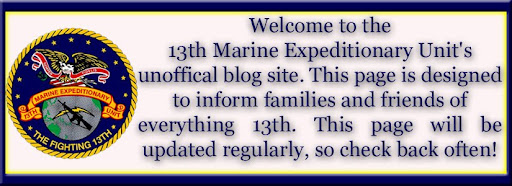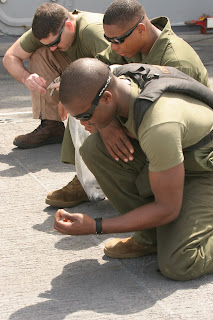 In the humid lower decks of USS Comstock (LSD 45), 30 Marines showed their intensity as they participated in the Marine Corps Martial Arts Program to earn their green belt, June 19.
In the humid lower decks of USS Comstock (LSD 45), 30 Marines showed their intensity as they participated in the Marine Corps Martial Arts Program to earn their green belt, June 19.Vital to the Marines development throughout the course was Martial Arts Instructor Trainer Staff Sgt. Mark K. McCue, supply chief with Combat Logistics Battalion 13, 13th Marine Expeditionary Unit.
“As a martial arts instructor trainer my main focus is the instructors in the battalion, helping
 them upgrade [belts] so that they can train more users,” said McCue, from Phoenix. “Due to lack of instructors in the battalion, I have been running tan, grey and green-belt courses.”
them upgrade [belts] so that they can train more users,” said McCue, from Phoenix. “Due to lack of instructors in the battalion, I have been running tan, grey and green-belt courses.”In addition to training Marines, McCue gives sailors the opportunity to participate in the program as well.
“It’s a great program for Marines to go through,” says McCue. “This training makes a complete and well-rounded warrior; passing this knowledge to the Navy is something that I enjoy doing. They get into it and are willing to do the same training
 the Marines do.”
the Marines do.”When it is muggy and humid down in the ship’s cargo departments, it makes combat conditioning interesting, McCue says.
“It’s really intense and it makes you put out,” said Cpl. Alfonso Chaves, from Dallas, with Communications Detachment, CLB-13, and a student in the green-belt course. “The hot atmosphere does play mind games on you when you train, but that just makes you more ready for any kind of situation you might be in.”
McCue has been an instructor for about five years and safety is one of his primary concerns.

“Operational Risk Management is a big concern of mine here on ship,” said McCue. “Making sure we are training the Marines properly, safely and at the same time getting the fullness of the program across to the Marines.”
“As an instructor I need to be watching the students very closely, I do everything they are doing so I can gage where we are at on a physical level,” said McCue. “What may be no big deal back at Camp Pendleton where we are used to training can be very different in this atmosphere—it could cause a Marine to become a heat casualty.”
McCue says MCMAP is based on a synergy of mental, character and physical discipline. Without one of these aspects the program would fail.
“Leadership is a big focus—character discipline, doing the right thing when nobody is looking and
 being able to push though when you feel you have exhausted all your energy,” said McCue. “It’s teaching the Marines how to utilize their interpersonal violence by learning how to control it.”
being able to push though when you feel you have exhausted all your energy,” said McCue. “It’s teaching the Marines how to utilize their interpersonal violence by learning how to control it.”Regardless of job, any Marine can be called on in a combat situation to utilize their skills.
“He is a good instructor, he definitely motivates the class,” said Chaves. “You can tell he spends a lot of time and effort into his classes.”“It’s great to pass on knowledge to Marines and makes a difference in the Marine Corps,” concluded McCue. “To watch a Marine improve and stay motivated is great.”





















 Lance Cpl. Phillip A. Fowler, from Nacogdoches, Texas, scout team leader with Light Armored Reconnaissance Platoon, Battalion Landing Team 1/1, 13th Marine Expeditionary Unit, runs down a hill during live-fire exercise in the Middle East. The training refined and refreshed the Marines’ fire and maneuvering skills, fire movement and combat marksmanship skills.
Lance Cpl. Phillip A. Fowler, from Nacogdoches, Texas, scout team leader with Light Armored Reconnaissance Platoon, Battalion Landing Team 1/1, 13th Marine Expeditionary Unit, runs down a hill during live-fire exercise in the Middle East. The training refined and refreshed the Marines’ fire and maneuvering skills, fire movement and combat marksmanship skills. Petty Officer 3rd Class Peter T. Wells, from Copperas Cove, Texas, corpsman with Light Armored Reconnaissance Platoon, Battalion Landing Team 1/1, 13th Marine Expeditionary Unit, prepares to load a rocket during a live-fire exercise in the Middle East. The training refined and refreshed the Marines’ fire and maneuvering skills, fire movement and combat marksmanship skills.
Petty Officer 3rd Class Peter T. Wells, from Copperas Cove, Texas, corpsman with Light Armored Reconnaissance Platoon, Battalion Landing Team 1/1, 13th Marine Expeditionary Unit, prepares to load a rocket during a live-fire exercise in the Middle East. The training refined and refreshed the Marines’ fire and maneuvering skills, fire movement and combat marksmanship skills.  Petty Officer 3rd Class Peter T. Wells, from Copperas Cove, Texas, corpsman with Light Armored Reconnaissance Platoon, Battalion Landing Team 1/1, 13th Marine Expeditionary Unit, prepares to load a rocket during a live-fire exercise in the Middle East. The training refined and refreshed the Marines’ fire and maneuvering skills, fire movement and combat marksmanship skills.
Petty Officer 3rd Class Peter T. Wells, from Copperas Cove, Texas, corpsman with Light Armored Reconnaissance Platoon, Battalion Landing Team 1/1, 13th Marine Expeditionary Unit, prepares to load a rocket during a live-fire exercise in the Middle East. The training refined and refreshed the Marines’ fire and maneuvering skills, fire movement and combat marksmanship skills. Lance Cpl. Kevin P. Herron, a Checotah, Okla. native and fire team leader with Light Armored Reconnaissance Platoon, shouts out commands to his fire team during a live-fire exercise in the Middle East. The training refined and refreshed the Marines’ fire and maneuvering skills, fire movement and combat marksmanship skills.
Lance Cpl. Kevin P. Herron, a Checotah, Okla. native and fire team leader with Light Armored Reconnaissance Platoon, shouts out commands to his fire team during a live-fire exercise in the Middle East. The training refined and refreshed the Marines’ fire and maneuvering skills, fire movement and combat marksmanship skills. Corporal Brady L. Gossett, scout team leader from Warrenton, Mo., and Lance Cpl. Curtis Shirey, scout and Flint, Mich. native, both with Light Armored Reconnaissance Platoon, Battalion Landing Team 1/1, 13th Marine Expeditionary Unit, assembles an M82A1 Special Application Scoped Rifle (SASR) during a marksmanship portion of their training in the Middle East. The training refined and refreshed the Marines’ fire and maneuvering skills, fire movement and combat marksmanship skills.
Corporal Brady L. Gossett, scout team leader from Warrenton, Mo., and Lance Cpl. Curtis Shirey, scout and Flint, Mich. native, both with Light Armored Reconnaissance Platoon, Battalion Landing Team 1/1, 13th Marine Expeditionary Unit, assembles an M82A1 Special Application Scoped Rifle (SASR) during a marksmanship portion of their training in the Middle East. The training refined and refreshed the Marines’ fire and maneuvering skills, fire movement and combat marksmanship skills. Sergeant DeAndray L. Dyer, from Kalamazoo, Mich., vehicle commander with Light Armored Reconnaissance Platoon, Battalion Landing Team 1/1, 13th Marine Expeditionary Unit, spots his gunner as he shoots a 25 millimeter chain gun round down range during a training exercise in the Middle East. The training refined and refreshed the Marines’ fire and maneuvering skills, fire movement and combat marksmanship skills.
Sergeant DeAndray L. Dyer, from Kalamazoo, Mich., vehicle commander with Light Armored Reconnaissance Platoon, Battalion Landing Team 1/1, 13th Marine Expeditionary Unit, spots his gunner as he shoots a 25 millimeter chain gun round down range during a training exercise in the Middle East. The training refined and refreshed the Marines’ fire and maneuvering skills, fire movement and combat marksmanship skills. 

















